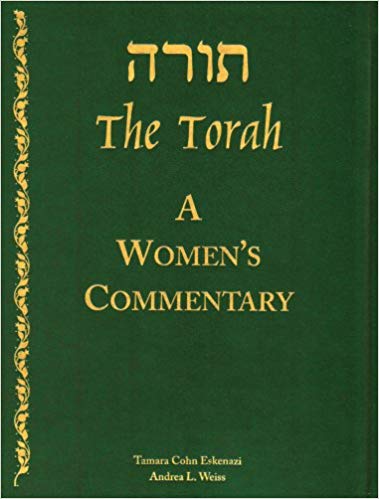The award-winning compendium “The Torah: A Women’s Commentary” began its journey to publication with a midrashic, or interpretative, question: Where was Sarah when Abraham took their son up to Mount Moriah to be sacrificed? A Reform cantor, Sarah Sager, posed that question just over 25 years ago as a scholar-in-residence at a temple in New York. As she researched her d’var Torah, or sermon, on the Torah portion of the week, Vayera, she realized she was among the first to ask the question pointedly about Sarah.
Twenty-five years later, the groundbreaking “The Torah: A Women’s Commentary”—featuring women’s original scholarship—is celebrating its 10th anniversary of publication. Women entered the arena of Jewish scholarship in higher numbers after the first woman was ordained at an acknowledged rabbinical seminary in 1972. From there, it took a generation for women to establish the academic credentials in Bible and rabbinics to be able to publish the landmark volume.
The Central Conference of American Rabbis published the book, and Blu Greenberg of the Jewish Orthodox Feminist Alliance (JOFA) lauded it for its inclusiveness. Giving her remarks at the National Jewish Book Council when it won Book of the Year in 2008, she said: “Here are voices of women from across the entire spectrum of Jewish life. … Although this work was funded, shepherded, overseen, edited and largely produced by two extraordinary Jewish scholars, it does not have the feeling of being owned by any one group, which explains why it has become the property of the whole Jewish community, as indeed any good commentary should.”

Rabbi Dr. Andrea Weiss, a co-editor of the book, recalled that the first significant step toward publishing the volume happened in 1995. A gathering in Newark, N.J., brought together Reform women leaders, rabbis and scholars to explore the idea of what a women’s Torah commentary might look like. “I was working on my Ph.D. in Bible at that point,” Weiss told JewishBoston. “We asked questions such as how long will the volume be, who would write it and how much would it cost. We didn’t have all the answers, but there was an enthusiasm to move forward.”
With financial backing from the Women of Reform Judaism, Weiss and her colleagues created a pilot program. In the process, Dr. Tamara Cohn Eskenazi, the volume’s editor-in-chief, told JewishBoston: “Our first challenge was to decide what do we mean by categories like ‘Jewish,’ ‘women’ and ‘contemporary,’ which were our goals for the format of the commentary. We quickly concluded that diversity is the key. We wanted to know and transmit what women, qualified and knowledgeable women, have to say about our sacred texts.”
Over the years leading up to its publication, Weiss and Cohn Eskenazi previewed much of the commentary in women’s study groups in synagogues and scholar-in-residence weekends. Weiss said that in the latter setting, she would inevitably be asked: “Why not publish just a new commentary on the Torah? By calling it a ‘women’s volume’ you potentially lose half the audience.”
In response, Weiss and Cohn Eskenazi noted that biblical commentary was long the domain of male scholars. Now was the time to give women a seat at the table with regard to text study and commentary. In an opinion piece Weiss wrote when the commentary was first published, she observed: “NO ONE questions why women should read a Torah commentary written by men: for the longest time, that is all we had. So why should anyone ask whether or not men should read a Torah commentary written by women?”
After several years of trial and error, Weiss and Cohn Eskenazi settled on a unique approach in presenting the weekly Torah portions. A given Torah portion, or parsha, is interpreted in five distinct ways. The first interpretation is conveyed through a “central commentary” containing the Hebrew text alongside a gender-accurate translation. Women characters that appear in the parsha, as well as related feminist issues, are highlighted in these essays.
A shorter essay under the rubric “Another View” homes in on a specific verse or section of the Torah that dialogues with a point made in the central commentary. Interpretation for this essay includes post-biblical commentaries from rabbinic literature and classical Jewish midrash, or commentaries. The point is to show how these interpretations incorporate women into their responses. Another more contemplative and philosophical approach is reflected in essays that fall under the category of “Contemporary Reflections.” The Torah can be challenging to today’s Jews, and these essays demonstrate its relevance in modernity.
The fifth section, entitled “Voices,” is more expansive and presents creative responses, mainly in the form of poetry, to the parsha of the week. For the commentary’s editors, featuring poetry offered both fresh insights and another way to access the parsha. Noted Weiss: “If the parsha is speaking clinically about the period of impurity after the birth of a baby, we paired it with a poem about giving birth in a personal, celebratory way. It adds a totally different dimension. We see ourselves in the Torah text, and it bridges some of the distance.”
This five-pronged approach to Torah commentary harkens back to the way Jewish texts have been preserved through the centuries. The pages of the commentary intentionally allow the essays to emulate an extended Talmudic-like conversation for a given Torah portion. “In this sense,” said Cohn Eskenazi, “this is tradition. As women, we relish dialogue. As a result, each Torah portion has five distinct sections that form a dialogue. No other commentary had this model, although it has since been adopted by others.”
Echoing Greenberg’s remarks about the commentary’s diversity of viewpoints and contributors, Cohn Eskenazi emphasized the “extraordinary camaraderie, generosity and goodwill that typified over 100 contributors and the superb and hard-working editorial board.” As she further noted, women worked together on the commentary without ego, turf wars or acrimony. “The enthusiastic commitment by all participants stands as a landmark to be celebrated,” she said.



